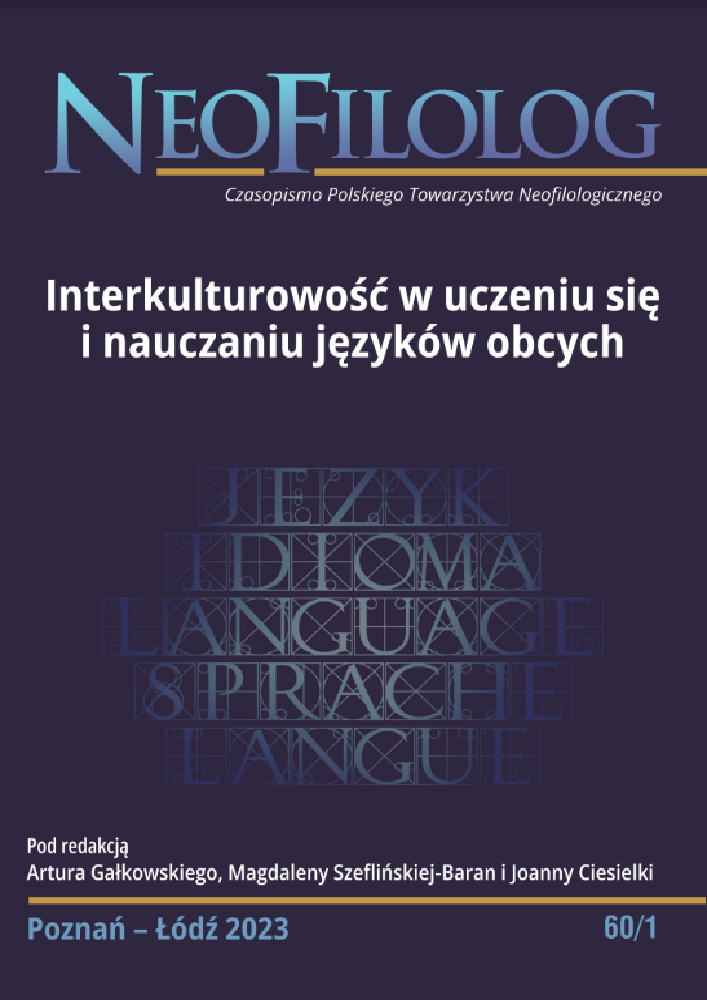Résumé
Didactic translations and translation projects are one of the ways of familiarising students simultaneously with a foreign language and culture, allowing them to develop language competences and learn about cultural similarities and differences. The aim of this article is to present a way of acquainting students with elements of foreign culture through translation, show the benefits of working with translation for language learning and present difficulties related to the translation of cultural elements and solutions used by translators. Teaching language and culture through translation has many advantages. First of all, working with the original text gives students access to the elements of the source culture in a specific communication context. Moreover, the translation assumes an in-depth understanding of the original, including intercultural allusions and intertextual references. The effort put into the translation process by the students makes them better memorize foreign elements and structures.
Références
Andresen de Mello Breyner S. (1996), Contos exemplares. Porto: Figueirinhas.
Andresen de Mello Breyner S. (2018), Opowiadania przykładne. Lublin: Wydawnictwo UMCS.
Banach B. (2001), Interkulturowa tendencja we współczesnej glottodydaktyce, (w:) Habrajska G. (red.), Język w komunikacji. t.3. Łódź: Wydawnictwo Wyższej Szkoły Humanistyczno-Ekonomicznej, s. 228–242.
Bennett M. (1998), Intercultural Communication: A Current Perspective, (w:) Bennett M. (red.), Basic Concepts of Intercultural Communication. Yarmouth: Intercultural Press, s. 1–34. DOI: https://doi.org/10.1002/9781118783665.ieicc0178
Berman A. (2009), Przekład jako doświadczenie obcego, (w:) Bukowski P., Heydel M. (red.), Współczesne teorie przekładu. Kraków: Znak, s. 249–264.
Byram M. (1997), Teaching and Assessing Intercultural Communicative Competence. Clevedon: Multilingual Matters.
Dunin-Dudkowska A. (2011), Tłumaczenia dydaktyczne w nauce języka polskiego jako obcego. „Acta Universitatis Lodziensis. Kształcenie Polonistyczne Cudzoziemców”, nr 18, s. 387–392.
Giczela-Pastwa J., Biel Ł. (2021), Kooperacyjne uczenie się przekładu – 15 lat działalności Studenckiego Koła Naukowego Przekładu Specjalistycznego LINGUANA, (w:) Kubińska O., Kuniński W., Kur M. (red.), Dydaktyka przekładu. Nauczanie przez projekty. Gdańsk: Wydawnictwo Uniwersytetu Gdańskiego, s. 79–98.
Grucza F. (1979), Metody, techniki i ćwiczenia glottodydaktyczne, (w:) Grucza F. (red.), Polska myśl glottodydaktyczna 1945-1975. Wybór artykułów z zakresu glottodydaktyki ogólnej. Warszawa: PWN, s. 314–326.
Hinc J., Jarosz A. (2019), Tłumaczenia dydaktyczne w nauczaniu języka obcego – przykłady ćwiczeń na zdania warunkowe, (w:) Grabowska M., Hinc J., Jarosz A., Mampe J. (red.), Translatoryka i glottodydaktyka. Od teorii do praktyki. Gdańsk: Wydawnictwo Uniwersytetu Gdańskiego, s. 201–214.
Janowska I. (2015), Kompetencja komunikacyjna a glottodydaktyka, „LingVaria”, nr. 2, s. 41–54. DOI: https://doi.org/10.12797/LV.10.2015.20.04
Komorowska, H. (1996). Nowe tendencje w pracach programowych Rady Europy. Koncepcja celów nauczania języków obcych, „Języki Obce w Szkole”, nr 2, s. 109–115.
Komorowska H. (1999), Metodyka nauczania języków obcych. Warszawa: WSiP.
Lefevere A. (1992), Translation, Rewriting and the Manipulation of Literary Fame. Londyn i Nowy Jork: Routledge.
Lewicki R. (2002), Obcość w przekładzie a obcość w kulturze, (w:) Lewicki R. (red.), Przekład. Język. Kultura. Lublin: UMCS, s. 43–51.
Lipińska E., Seretny A. (2016), Tłumaczenie w nauczaniu/uczeniu się języka obcego – od słowa do tekstu, (w:) Lipińska E., Seretny A. (red.), Tłumaczenie dydaktyczne w nowoczesnym kształceniu językowym. Kraków: Księgarnia Akademicka, s. 23–35.
Nagórko A. (2004), Metody konfrontatywne a etnolingwistyka (lingwistyka kulturowa), (w:) Flórián E. (red.), Wielokulturowość, tożsamość narodowa, mniejszości na Węgrzech i w Polsce: język, literatura, kultura. Debreczyn: Kossuth Egyetemi K., s. 25-33.
Newmark P. (1988), Approaches to Translation. Hertfordshire: Prentice Hall.
Tomaszkiewicz T. (2006), Terminologia tłumaczenia. Poznań: UAM.
Toury G. (2000), The nature and role of norms in translation, (w:) Venuti L. (red.), The Translation Studies Reader. Londyn i Nowy York: Routledge, s. 199–211.
Venuti L. (2009), Przekład, wspólnota, utopia, (w:) P. Bukowski, M. Heydel (red.), Współczesne teorie przekładu. Kraków: Wydawnictwo Znak, s. 267–293.
Żydek-Bednarczuk U. (2012), Kompetencja międzykulturowa w nauczaniu języka polskiego jako obcego. „Postscriptum Polonistyczne”, nr 2 (10), s. 19–30.
Licence
© Agnieszka Kruk 2023

Ce travail est disponible sous licence Creative Commons Attribution - Pas de Modification 4.0 International.
Auteurs :
Les auteurs de textes acceptés pour publication dans la revue Neofilolog sont tenus de remplir, signer et renvoyer à l'adresse de la rédaction, un accord sur l'octroi d'une licence gratuite pour les œuvres, avec obligation d'accorder une sous-licence CC.
En vertu de cet accord, les auteurs des textes publiés dans la revue Neofilolog accordent à l'Université Adam Mickiewicz de Poznań une licence non exclusive et gratuite et permettent l'utilisation de la sous-licence Creative Commons Attribution-NoDerivatives 4.0 International (CC BY-ND 4.0).
Les auteurs se réservent le droit de disposer librement de l'œuvre.
Utilisateurs :
Les utilisateurs d'Internet intéressés ont le droit d'utiliser les œuvres publiées à partir de l'année 2017 sous réserve des conditions suivantes :
- reconnaissance de la qualité d'auteur - l'obligation de fournir des informations sur la qualité d'auteur, le titre, la source (liens vers l'œuvre originale, DOI) et la licence, ainsi que l'œuvre distribuée ;
- sans créer d'œuvres dérivées - l'œuvre doit être conservée dans sa forme originale, p. ex. les traductions ou les interprétations ne peuvent être distribuées sans le consentement de l'auteur.
Tous les textes publiés sont soumis au droit d'auteur.
Autres :
L'Université Adam Mickiewicz de Poznań se réserve le droit à la revue dans son ensemble (mise en page, forme graphique, titre, conception de la couverture, logo, etc.).
.

